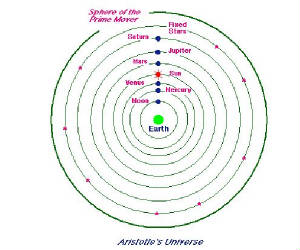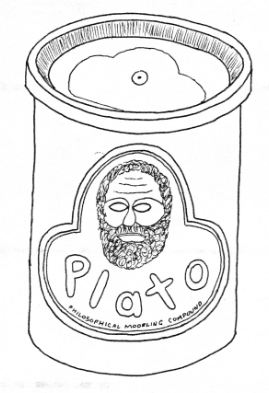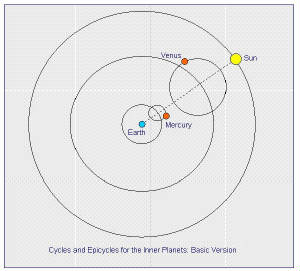Epicycles
Epicycles were the solution to a complex problem.
The idea that the Earth sits squarely in the center in the center of the Universe with the rest of the cosmos emanating out
in concentric circles, with heaven above and the devil below, has been around for a very long time.

God’s Dart
Board (The Universe of Aristotle and Ptolemy)
Astronomers had been keeping records in early Babylonia since the 19th century
Before the Common Era, (History of Babylon), and the Chinese have been keeping records of the stars since at least 3000 BCE,
and probably for a lot longer than that. (Ancient Chinese Astronomy) And though we may not have intact records
from other ancient cultures, we can be fairly certain they weren’t ignoring the stars, either. And they all concluded
the same thing: The earth is in the center of the Universe. And why not? After all, if you watch the stars
for very long at all, that’s exactly what they do – they go in circles around the earth, and so does the moon
and the sun... more or less. It’s the planets that are... a bit more problematic.
All these things circling the earth even got more
confusing when early astronomers and philosophers began questioning just exactly how that all worked. Enter Plato who
came on the scene around four hundred years before the birth of Christ. (Plato)

Plato, seemingly determined to make things more confusing than they already were, felt “...that the world was
constructed with geometric simplicity and elegance....” He believed that the circle was the simplest form of uniform
motion, and if something were going to repeat itself endlessly, which the universe seemed to be doing, then the best way to
do it had to be a circle – a perfect circle. (Fowler)
But there were just two small problems with that idea. One, the earth, as those of us who didn’t
attend public school in Texas, Kansas, or Mississippi know, is not in the center of the universe, and two, nothing
in space goes in a perfect circle, much less the planets’ orbits of the sun. And that’s were epicycles come
in.
Early astronomers knew that the
planets were not the same as stars from just about forever. The planets move faster than the stars around them, they
are often brighter, and they do this funky thing called retrograde motion. That’s when we pass a planet in orbit,
or that planet passes us. It happens more often than one might think. What the planet appears to do when that
happens, over the course of several evenings, is to slow down, stop, then go the opposite direction before slowing down, stopping
once again, and then going back in the direction it was originally heading. (Strobel) Think about passing another
car on the highway, but you don’t realize you’re moving, too.
That sort of thing would mess with even the best models, much less a model where the only
path possible was a perfect circle, and a model of the Universe is exactly what Plato challenged his colleagues to make, which
is a lot easier than doing it yourself. And they did!
Of course, they also came up with some pretty crazy stuff as well, such as was envisioned by Eratosthenes
and Aristarchus around the 3rd Century BCE, (Size of the Earth...) who came up with the idea that it was
the sun that stayed put and that the earth, while rotating on its axis once every 24 hours, went around the sun. (Fowler)
Now who’s going to believe that?
Though
Plato first came up with the idea of an epicycle, it was Ptolemy in the 2nd Century CE who perfected the epicycle,
building on the earlier work of others, most notably Hipparchus, who developed trigonometry just to figure all this out. By
having a planet orbiting a point on a circle that orbits the point on another circle, which, if necessary, could be orbiting
a point on even another circle, and so on, Ptolemy came up with an ingenious model of the solar system (and ostensibly, the
Universe) – and the geometry to back it – that actually worked. He was able to prove, mathematically, that
the earth was, indeed, at the center of the Universe. And all of these circles on top of circles were called epicycles.
(Fowler)

Epicycles (Fowler)
And then along
came the Catholic church, and not long after that, syncretism: The blending of pagan and Christian traditions.
In a pea pod, it was the attempt of early Christian theologians (among others) to make everything that clearly had nothing
to do with Christianity a part of the Christian tradition. (Botkin) To these theologians, it made perfect sense
that if we are God’s primary creation, then we should be smack dab in the center of everything. And, if God is
going to make something, then it wouldn’t be anything less than perfect. And nothing was more perfect than a circle.
And so Ptolemy’s model of the universe with
all of its epicycles became part of the dogma of the Catholic church. It other words, it became the word of God that
the earth was in the center of the Universe. (The History of Dogmatic Thought) And there it stayed until 1543,
when Copernicus published The Revolution of the Celestial Spheres, in which he suggested that it was the sun that
stayed put and the earth that did the loop-to-loops. (Wudka) Copernicus was wise enough, though, not to directly
challenge the Catholic Church, but instead presented his ideas as just a theoretical way of understanding the universe.
Galileo, on the other hand, believed he could convince the church that it was wrong. After all, the Pope was one of
his buddies, and it had been over a century since Copernicus had publically introduced the idea. That friendship (though
a bit strained) was probably the only thing that kept Galileo from being killed for heresy, that, and he renounced his theories,
more or less. (Loy)
But the dogma
had been let out of the kennel, so to speak. The world was clearly round, as attested to by Columbus and other early
explorers, and everybody who tested Galileo’s theories with his newly improved telescope could clearly see that he was
correct. The world could no longer return to believing it was in the center of the Universe. Of course, the Catholic
Church was a bit slower, not removing Galileo’s book, Dialogue Concerning
the Two Chief World Systems, from their Index of banned books until 1835, and not officially admitting that they were
wrong until 1979. (Loy)
To me, Epicycles
have come to represent how easy it is to prove that something is true when you believe it already is before, or even if, you
ever go looking for proof. As well, they represent how hard it is to change those beliefs which are clearly not right,
especially when those beliefs have gotten entangled with religion. Epicycles are nothing more than a clockwork
orange – a beautiful mechanism that does nothing. (Burgess) But yet they remain.
Work Cited
“Ancient Chinese Astronomy.”
2012. Experiments-Resources.com. 08 May 2012. http://www.experiment-resources.com/chinese-astronomy.html
Botkin, Daniel. “Syncretism: A Blending of Paganism and Truth by Dr. Daniel Botkin.”
Sept.-Oct. 2005. The Bible Sabbath Association. 08 May 2012. http://www.biblesabbath.org/tss/515/truth.html
Burgess, Anthony. A Clockwork Orange. New York: WWW Norton and Company, 1986.
Fowler,
Michael. “How the Greeks Used Geometry to Understand the Stars..” 16 Sept. 2008. The University
of Virginia. 07 May 2012. http://galileoandeinstein.physics.virginia.edu/lectures/greek_astro.htm
“History of Babylon.” History World. 08 May 2012. http://www.historyworld.net/wrldhis/PlainTextHistories.asp?historyid=aa10
“The History of Dogmatic Theology.” 2009. New Advent. 08 May 2012.
http://www.newadvent.org/cathen/14588a.htm
Loy, Jim. “Galileo and the Church.” 2002. Jim Loy’s Home Page. 08
May 2012. http://www.jimloy.com/biograph/galileo.htm
“Plato.” www.in2greece.com. 7 May 2012. http://www.in2greece.com/english/historymyth/history/ancient/plato.htm
“Size of the Earth and the Distances to the Moon and the Sun.” 19 Dec. 2011. Astro Washington.
08 May 2012. http://www.astro.washington.edu/courses/astro211/CoursePack/cp03a_distance_sun.pdf
Strobel, Nick. “Epicycles Explain Retrograde Motion.” 05 May 2001. Astronomy
Notes. 07 May 2012. http://www.astronomynotes.com/history/epicycle.htm
“The Universe of Aristotle and Ptolemy.” Astronomy 161: The Solar System.
07 May 2012. http://csep10.phys.utk.edu/astr161/lect/retrograde/aristotle.html
Wudka, Jose. “The Copernican Revolution.” 24 Sept. 1998. University of California
– Riverside: Physics and Astronomy. 08 May 2012. http://physics.ucr.edu/~wudka/Physics7/Notes_www/node41.html